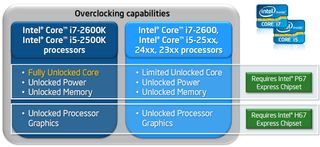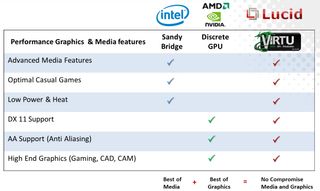Can Lucidlogix Right Sandy Bridge’s Wrongs? Virtu, Previewed
Quick Sync was Intel's secret Sandy Bridge weapon, kept quiet for five years and unveiled at the very last moment. But there's a chance that desktop enthusiasts will miss out on that functionality. That is, unless Lucidlogix has anything to do with it.

GPU Virtualization Enables Quick Sync And Discrete Graphics
The quest to differentiate pits engineers against marketers. On one side, you have teams of brilliant people trying to figure out how to design the best product possible. On the other, often equally-intelligent minds are devoted to extracting maximum profit from those same products. When both camps strike a harmonious balance, the result is usually something that enthusiasts are willing to embrace.
I’m singling out the hardcore users for a reason. We’re willing to pay good money for a Core i7-2600K because its complete feature set is downright impressive. We know the speeds and feeds. We know what to expect. We know damn well when something is being taken away from us. And we know that when we don’t like something, we can speak with our wallets.

Mom, dad, my wife—they don’t care if they buy an H67-based motherboard today and can’t overclock their processor tomorrow. Instead they count on a system builder to put the right components together. But we know better.
Frankly, the chipset side of Intel’s Sandy Bridge launch soured the deal for enthusiasts who salivated over Quick Sync functionality and then learned it required H67 Express—the only desktop chipset capable of exposing the HD Graphics engine, but designed to artificially crush processor overclocking efforts. Bad marketing, bad.
Video Enthusiasts: Wait For Z68
If Quick Sync means nothing to you, then carry on. P67 Express is probably the platform that’ll make you happiest, especially if you purchase a K-series processor.
If the ability to slash 80% off of your transcode times sounds sexy though, and you can’t live without discrete graphics, wait for Z68 Express, expected in the May/June time frame. The Z68 chipset will make it possible to:
Stay on the Cutting Edge
Join the experts who read Tom's Hardware for the inside track on enthusiast PC tech news — and have for over 25 years. We'll send breaking news and in-depth reviews of CPUs, GPUs, AI, maker hardware and more straight to your inbox.
- Overclock your K-series chip through manual clock ratio selection
- Utilize integrated graphics, freeing up overclocking of that component, too
- Enable SSD-based caching—but more on that later
That still leaves us with a problem, though. It’s possible for HD Graphics 3000 to coexist alongside a discrete graphics card in a Z68-based machine. However, nobody is going to get behind their PC to swap display outputs and restart every time they want to transcode a video or play a game. That’d eat up any potential time savings from Quick Sync super-fast.
Lucidlogix To The Rescue
But Lucidlogix—the same company we've seen try to unify multi-card rendering solutions from AMD and Nvidia—has an answer that it hopes will make Z68 an even more viable solution for enthusiasts: GPU virtualization. Using the company’s Virtu software, you can connect a display to the output of an H67- or Z68-based motherboard, drop in a discrete card, and harness the capabilities of both components.

Virtu is generic in that it conceptually doesn’t care if you’re using an add-in card from AMD or Nvidia, or an integrated graphics solution from Intel or AMD. It's only being validated on Sandy Bridge-based platforms today, but we expect that there will be a time when Lucid officially adds support for other configurations as well. It just so happened that Intel left an opportunity wide open by limiting access to Quick Sync for enthusiasts.
Sound like something Intel might have been counting on all along? Intel Capital is one of Lucidlogix’s investors, after all…
Current page: GPU Virtualization Enables Quick Sync And Discrete Graphics
Next Page Virtualizing The GPU: How It Works-
mister g I'm pretty sure that Fusion only works with AMD parts, but the idea whould be the same. Anybody else remember this company's ads on the side of some of Tom's articles?Reply -
I suppose a multi-monitor setup, main screen for gaming on the discrete card (assuming game only uses that one screen), secondary on the Z68 Output of the Intel HD card, will not have any need for this, and just run perfectly.Reply
Thats how i will roll, once Z68 gets out. -
haplo602 seems like we are heading to what voodoo graphics and TV tuners were doing long long time ago. just now over the PCIe bus.Reply
I wonder why it's so difficult to map framebuffers and create virtual screens ? -
RobinPanties This sounds like software technology that should be built straight into OS's, instead of added as separate layers... maybe OS manufacturer's need to wake up (*cough* Microsoft)Reply -
truehighroller I already sent back my sandy bridge setup, that's to bad. Guess it's Intel's loss huh?Reply -
lradunovic77 This is another absolutely useless piece of crap. Why in the world would you put deal with another stupid layer and why would you use Intel integrated graphic chip (or any integrated solution) along with your dedicated video card???Reply
Conclusion of this article is...don't go with such nonsense solution.
Most Popular


